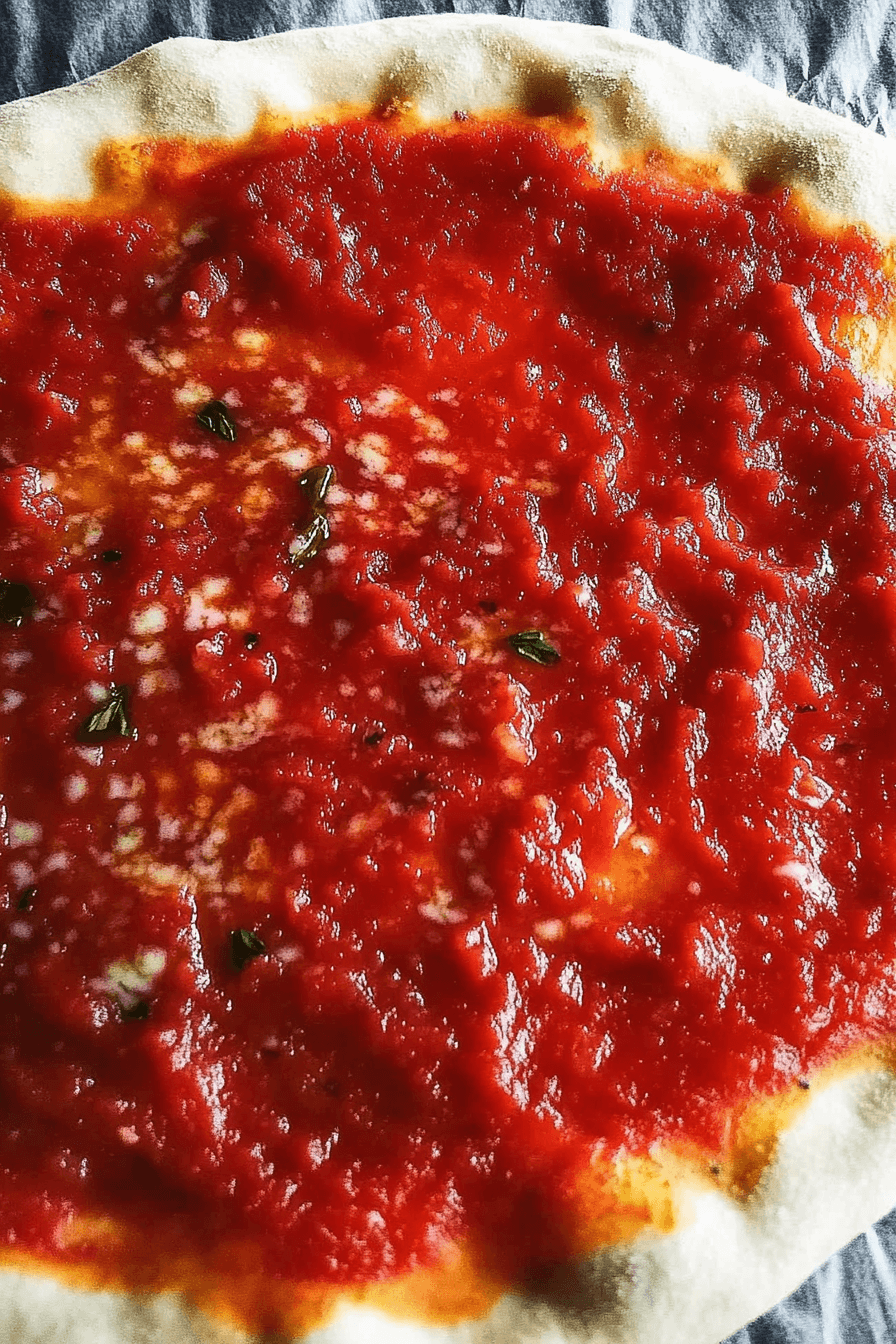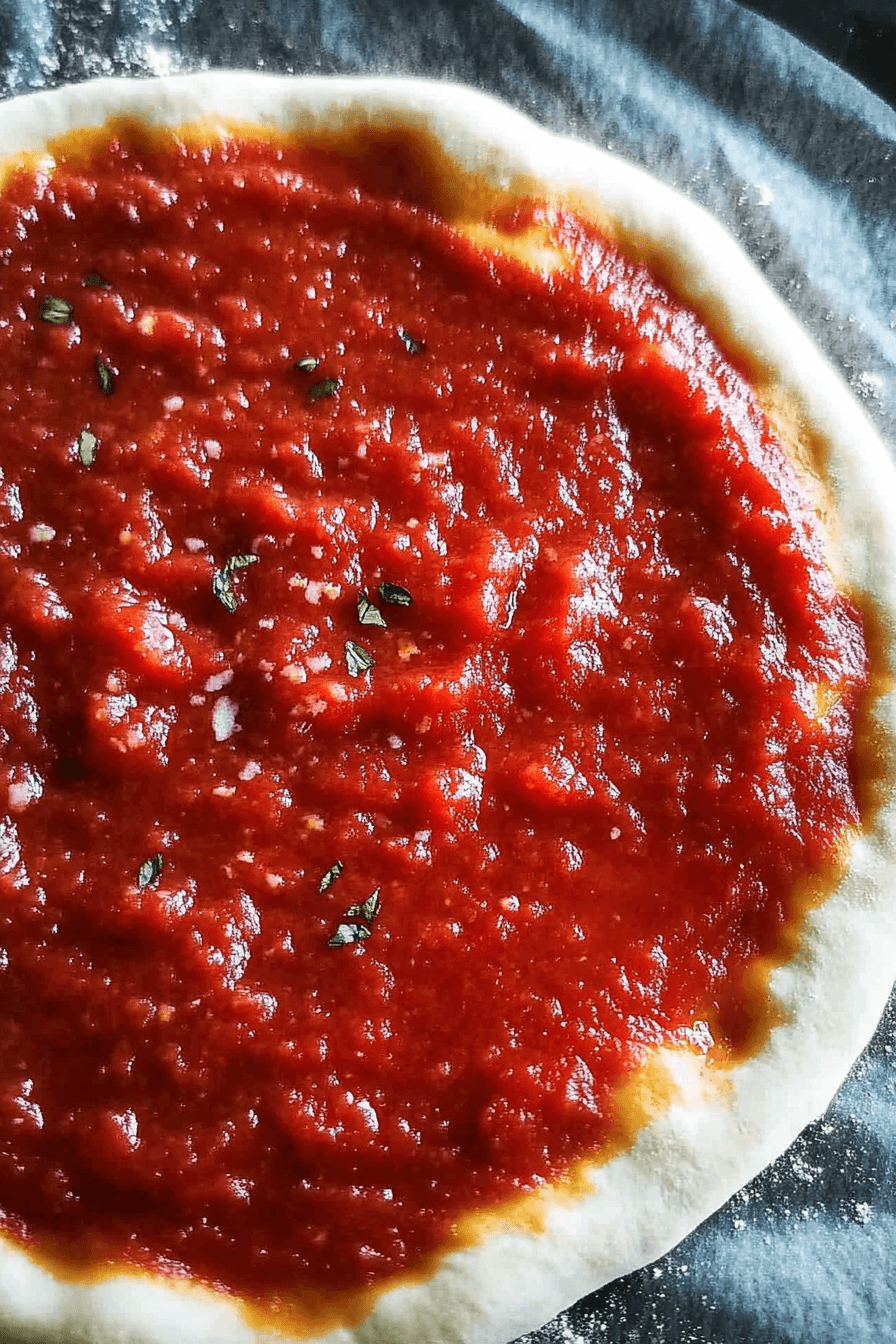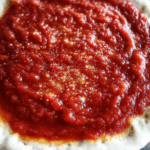Introduction to Homemade Pizza Sauce
Homemade pizza sauce is a delightful game-changer in the world of home cooking. Packed with bold flavors and made with just a few pantry staples, it’s vegan, gluten-free, and oh-so-simple to prepare. Whether you’re a busy parent, a student on a budget, or someone who loves indulging in authentic homemade flavors, this sauce is a perfect fit. Creating a memorable culinary experience has never been easier, and this five-minute recipe will have you wondering why you didn’t try it sooner. Not to mention, your homemade pizzas will be better than ever!
Benefits and Advantages of Homemade Pizza Sauce
Opting for homemade pizza sauce offers numerous benefits that you’ll appreciate with each bite. First and foremost, the simplicity of preparation is unmatched, requiring just a handful of common ingredients like tomato puree and olive oil. This sauce is not only cost-effective but also free from mysterious additives found in many store-bought options. With homemade pizza sauce, you can control the flavors, adjust the seasoning, and create a deliciously thick consistency that prevents soggy crusts. Moreover, it’s versatile enough to suit different dietary needs, making it an inclusive choice for nearly everyone around your table.

Ingredients Overview
Essential Ingredients for homemade pizza sauce
Creating a flavorful homemade pizza sauce starts with the right ingredients. Here’s a detailed list of what you’ll need:
- Tomato Sauce or Puree: 2 cups. This forms the base, providing a rich, tangy flavor.
- Tomato Paste: 2 tablespoons. It thickens the sauce, preventing a soggy crust.
- Olive Oil: 2 tablespoons. Adds depth and a smooth texture.
- Garlic: 2 cloves, minced. Infuses a warm, aromatic essence into the sauce.
- Dried Herbs: 1 tablespoon of Italian seasoning or a mix of oregano and basil.
- Sugar: 1 teaspoon. Balances the tomatoes’ acidity, lending a subtle sweetness.
- Salt: 1 teaspoon. Enhances the flavors of other ingredients.
- Optional – Red Pepper Flakes: 1/4 teaspoon for a touch of heat.
For those with dietary restrictions, rest assured, the sauce is naturally vegan and can be made gluten-free. Additionally, it is a low-calorie option, perfect for health-conscious individuals.
Dietary Substitutions to Customize Your homemade pizza sauce
Customizing this pizza sauce to meet specific dietary needs or ingredient availability is simple:
- Low-Sodium Option: Replace regular salt with a low-sodium version or simply reduce the amount used.
- Sugar-Free Version: Substitute sugar with a natural sweetener like stevia or omit it entirely for a tangier sauce.
- Garlic-Free Variation: For those sensitive to garlic, consider using garlic-infused olive oil instead or skip it altogether.
- Fresh Tomatoes: If you have fresh tomatoes, blanch and peel them, then use a blender to puree, replacing the canned tomato sauce.
Adjusting these ingredients allows you to craft a sauce that aligns with your taste preferences and dietary requirements. Remember, the goal is to create a sauce that fits seamlessly into your culinary adventures.
How to Prepare the Perfect homemade pizza sauce: Step-by-Step Guide
Crafting the perfect homemade pizza sauce is straightforward and quick. Follow this detailed guide to have your sauce ready in no time.
- First Step: In a medium-sized mixing bowl, combine the tomato sauce or puree and tomato paste. Stir until smooth.
- Second Step: Add in the olive oil. Mix thoroughly to ensure it’s evenly distributed, which helps the flavors meld.
- Third Step: Introduce the minced garlic to the mixture. If using garlic-infused olive oil as a substitute, ensure it’s well blended.
- Fourth Step: Stir in the dried herbs, sugar, and salt. If opting for Italian seasoning, it should provide a balanced blend of oregano, basil, and other spices, infusing your sauce with authentic Italian flavors.
- Fifth Step: For those wanting a hint of spice, incorporate red pepper flakes. Adjust according to your heat preference.
- Sixth Step: Taste the sauce and consider adjusting seasonings or adding a bit more sugar if a sweeter sauce is desired.
- Seventh Step: If planning to use fresh tomatoes, make sure they are well blended and free from lumps before starting the mixing process for a smooth consistency.
- Eighth Step: Let the sauce stand for about 10-15 minutes, allowing the flavors to marry. If you prefer, refrigerate for a more developed taste profile.
Follow these steps to achieve a restaurant-quality sauce. This homemade concoction is not only flavorful but also versatile, allowing alterations based on dietary needs or ingredient availability.

Mastering homemade pizza sauce: Advanced Tips and Variations
As you become more confident in making homemade pizza sauce, there are several advanced tips and variations you can explore to suit your taste and dietary needs. Here, we’ll share some secrets to take your sauce to the next level, ensuring it’s a hit for any meal.
Enhancing Flavor Profiles with Fresh Ingredients
While dried herbs are convenient, using fresh herbs can bring out more robust and vibrant flavors. Consider adding chopped fresh basil, oregano, or thyme to your sauce just before using it. A small amount of fresh minced garlic can also provide a sharper punch compared to garlic powder.
The Power of Slow Simmering
If time allows, simmering your pizza sauce gently over low heat for 15 to 30 minutes can deepen its flavor and create a thicker texture. This process allows the herbs and spices to meld better with the tomatoes, resulting in a rich and concentrated sauce. Be sure to stir occasionally to prevent sticking.
Introducing Sweetness without Sugar
For those who prefer to avoid added sugars, adding grated carrots or a splash of balsamic vinegar can naturally sweeten your sauce while enhancing its depth of flavor. These additions counterbalance the acidity of the tomatoes without compromising the sauce’s overall profile.
Creative Variations to Spice Things Up
- Spicy Kick: If you like your pizza with a bit of heat, a pinch of red pepper flakes or a dash of cayenne pepper can do wonders.
- Umami Boost: Add a teaspoon of soy sauce or a few anchovy fillets to introduce a savory umami note.
- Creamy Twist: Stir in a little cream or butter for a luxurious, rounded flavor.
Adjusting for Dietary Preferences
Your homemade pizza sauce can be effortlessly tailored to fit any dietary preference. For a vegan option, simply ensure that any additional ingredients (like butter) are plant-based. Gluten-free versions are naturally easy, as long as no cross-contaminated ingredients are used.
How to Store homemade pizza sauce: Best Practices
Proper storage of your homemade pizza sauce means it’s ready and delicious whenever you need it. Follow these best practices to maintain its freshness and flavor.
Refrigeration for Short-Term Storage
Homemade pizza sauce can be stored in an airtight container in the refrigerator for up to one week. Ensure the container is clean to prevent any bacterial growth that could spoil the sauce. Before covering, allow the sauce to cool completely to avoid condensation, which can lead to a watery consistency.
Freezing for Long-Term Availability
If you’ve made a big batch, freezing is an excellent way to preserve your sauce. Pour the sauce into ice cube trays for easy portioning and freeze until solid. Once frozen, transfer the cubes to a freezer-safe bag. Label with the date, and it will keep in the freezer for up to 3 months.
Reheating Tips
When you’re ready to use the sauce, thaw it in the refrigerator overnight or use the microwave on a low setting for quick defrosting. Once thawed, stir thoroughly to restore its smooth consistency. If the sauce appears too thick after reheating, add a tiny bit of water and stir until desired consistency is achieved.
Following these guidelines, your homemade pizza sauce will remain tasty and convenient, always ready to bring a touch of homemade goodness to your meals.

Nutritional Value of homemade pizza sauce
Making your own homemade pizza sauce is not only simple but also a healthy choice that allows you to control the ingredients and their nutritional benefits. Let’s break down the nutritional profile of this delicious sauce so you can understand exactly what you’re adding to your meals.
Calories and Macronutrients
In a typical serving of homemade pizza sauce, which is about half a cup, you can expect to find approximately:
- Calories: 40-60 calories, depending on the specific ingredients and their proportions.
- Protein: 1-2 grams, mainly from the tomatoes and any added vegetables or herbs.
- Fat: 0-2 grams, primarily from olive oil or any additional fats you might choose to use such as butter for richness.
- Carbohydrates: 7-10 grams, which mainly come from the tomato base.
Essential Vitamins and Minerals
Homemade pizza sauce offers a variety of essential vitamins and minerals:
- Vitamin C: Abundant in tomatoes, this vitamin supports the immune system and skin health.
- Potassium: Helps maintain healthy blood pressure levels and is crucial for nerve and muscle function.
- Vitamin A: Essential for eye health and immune function, also found in high amounts in tomatoes.
- Iron and Calcium: Though in smaller amounts, they are present and contribute to bone health and oxygen transport in the body.
Health Benefits
By choosing to make your own pizza sauce, you avoid preservatives and added sugars often found in store-bought versions. It allows you to stick with fresh ingredients, which can offer exceptional health benefits. For example, the antioxidants in tomatoes are known to reduce inflammation and promote heart health.
To enhance the nutritional value, consider adding additional ingredients like garlic and herbs that not only boost flavor but provide added health benefits.
For more information on the caloric details of pizza sauce ingredients, you might find this resource helpful.
FAQs: Frequently Asked Questions About homemade pizza sauce
Can I use fresh tomatoes instead of canned tomatoes for homemade pizza sauce?
Yes, you can absolutely use fresh tomatoes when making homemade pizza sauce! Choose ripe, juicy tomatoes for the best flavor. Blanch them to remove the skins, then puree or crush them for use in your sauce. This might yield a lighter, fresher taste compared to using canned tomatoes.
How long does homemade pizza sauce last in the refrigerator and freezer?
When stored properly in an airtight container, homemade pizza sauce will last for up to a week in the refrigerator. For longer storage, you can freeze the sauce for up to 3 months. Just be sure to store it in a freezer-safe container, leaving some room for expansion as it freezes.
What are some common ingredients used to make homemade pizza sauce?
Homemade pizza sauce is made with simple, fresh ingredients including tomato sauce or puree, tomato paste, olive oil, garlic, herbs like oregano and basil, and a touch of sugar to balance the acidity. Optionally, add ingredients like onions, butter, and red pepper flakes for additional flavors.
Do I need to cook homemade pizza sauce, or can it be used raw?
You can enjoy homemade pizza sauce both ways! While some recipes call for simmering the sauce to deepen the flavors and reduce water content, other recipes work perfectly well raw. If using raw, ensure your ingredients, particularly the garlic, are finely processed to ensure a smooth texture.
Using homemade pizza sauce can vastly improve the flavor profile of your meal, giving a fresh, personalized touch. To explore a delicious pizza recipe, check out Homemade Pepperoni Pizza.
For more details on crafting homemade pizza sauce, you might be interested in this guide that delves into the makings of pizza sauce.
Print
Homemade Pizza Sauce Recipe in 5 Minutes
- Total Time: 20 minutes
Description
🍕 Skip the store-bought sauces and enjoy a rich, flavorful homemade pizza sauce made with simple, wholesome ingredients! 🍅✨
🔥 Perfectly balanced with herbs, garlic, and a touch of sweetness, this easy-to-make sauce brings out the best in every slice! 🍕❤️
Ingredients
Tomato sauce or puree
Tomato paste
Olive oil
Garlic (fresh or powdered)
Dried oregano
Dried basil
Italian seasoning
Sugar
Salt
Canned whole peeled tomatoes (optional, crushed by hand or blended)
Onion (fresh or powdered)
Red pepper flakes (optional)
Butter (optional, for richness)
Instructions
1. Gather ingredients: tomato sauce or puree, tomato paste, olive oil, garlic, dried herbs (oregano, basil, Italian seasoning), sugar, salt, and optional red pepper flakes.
2. If using canned whole peeled tomatoes, crush them by hand or blend until smooth.
3. In a mixing bowl, combine tomato sauce or puree with tomato paste for a thicker consistency.
4. Add minced garlic or garlic powder and stir well.
5. Mix in dried herbs, adjusting quantities to taste.
6. Stir in a small amount of sugar to balance acidity.
7. Add salt to enhance overall flavor.
8. If using onion, add finely grated fresh onion or sprinkle in onion powder.
9. For added richness, mix in a small amount of melted butter (optional).
10. If making a no-cook version, let the flavors meld for at least 10 minutes before using.
11. For a cooked version, heat olive oil in a saucepan over medium heat.
12. Add the sauce mixture to the pan and bring to a gentle simmer.
13. Cook for 15-30 minutes, stirring occasionally, to concentrate flavors.
14. Taste and adjust seasoning as needed.
15. Let the sauce cool slightly before using on pizza dough.
16. Store any leftover sauce in an airtight container in the refrigerator for up to a week or freeze for longer storage.
Notes
Let the sauce simmer for at least 15 minutes to deepen the flavors and thicken the consistency.
Use a combination of tomato puree and tomato paste for a rich texture that won’t make your pizza soggy.
Store leftovers in an airtight container in the fridge for up to a week or freeze for longer storage.
- Prep Time: 5
- Cook Time: 15
- Category: Sauce
- Method: No Cook / Simmer
- Cuisine: Italian

